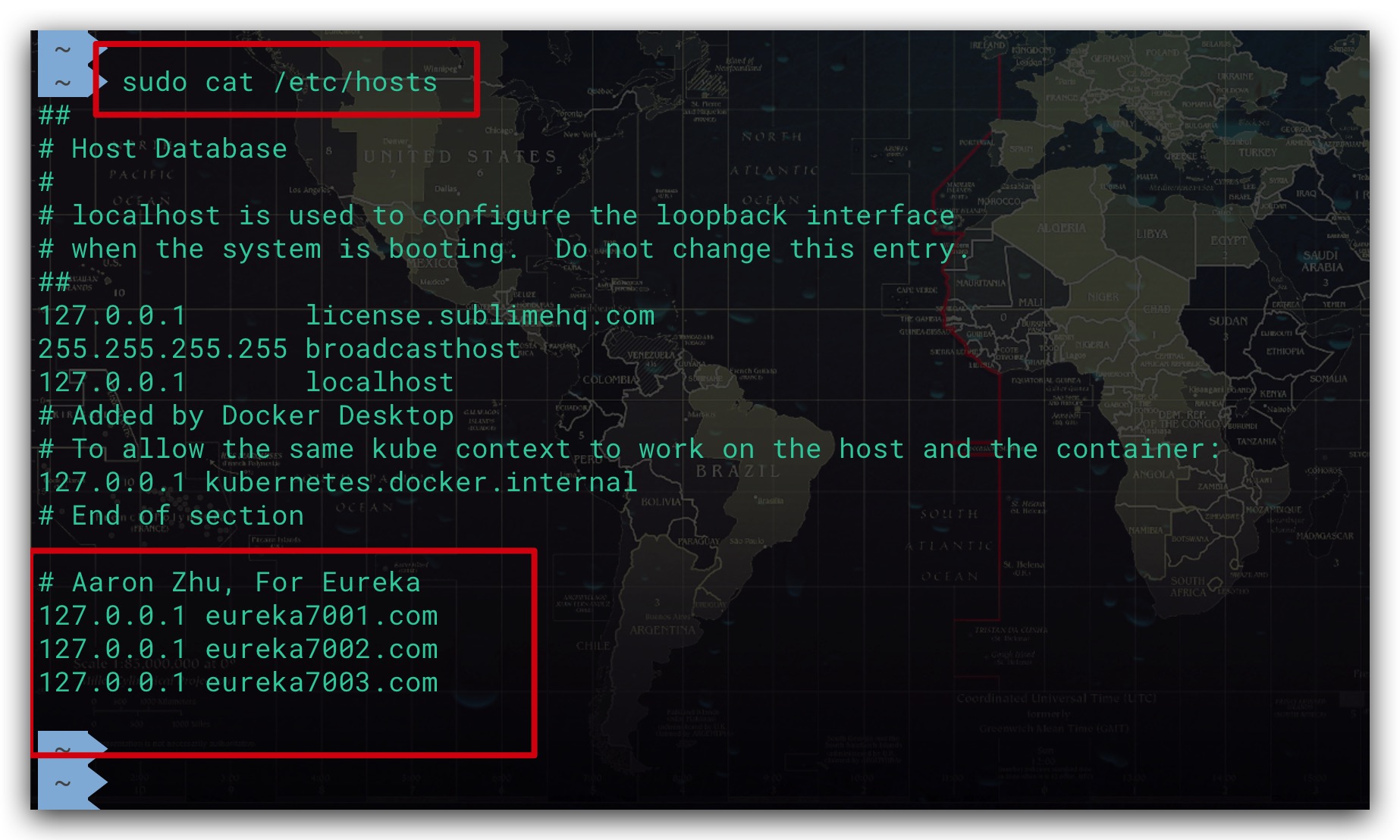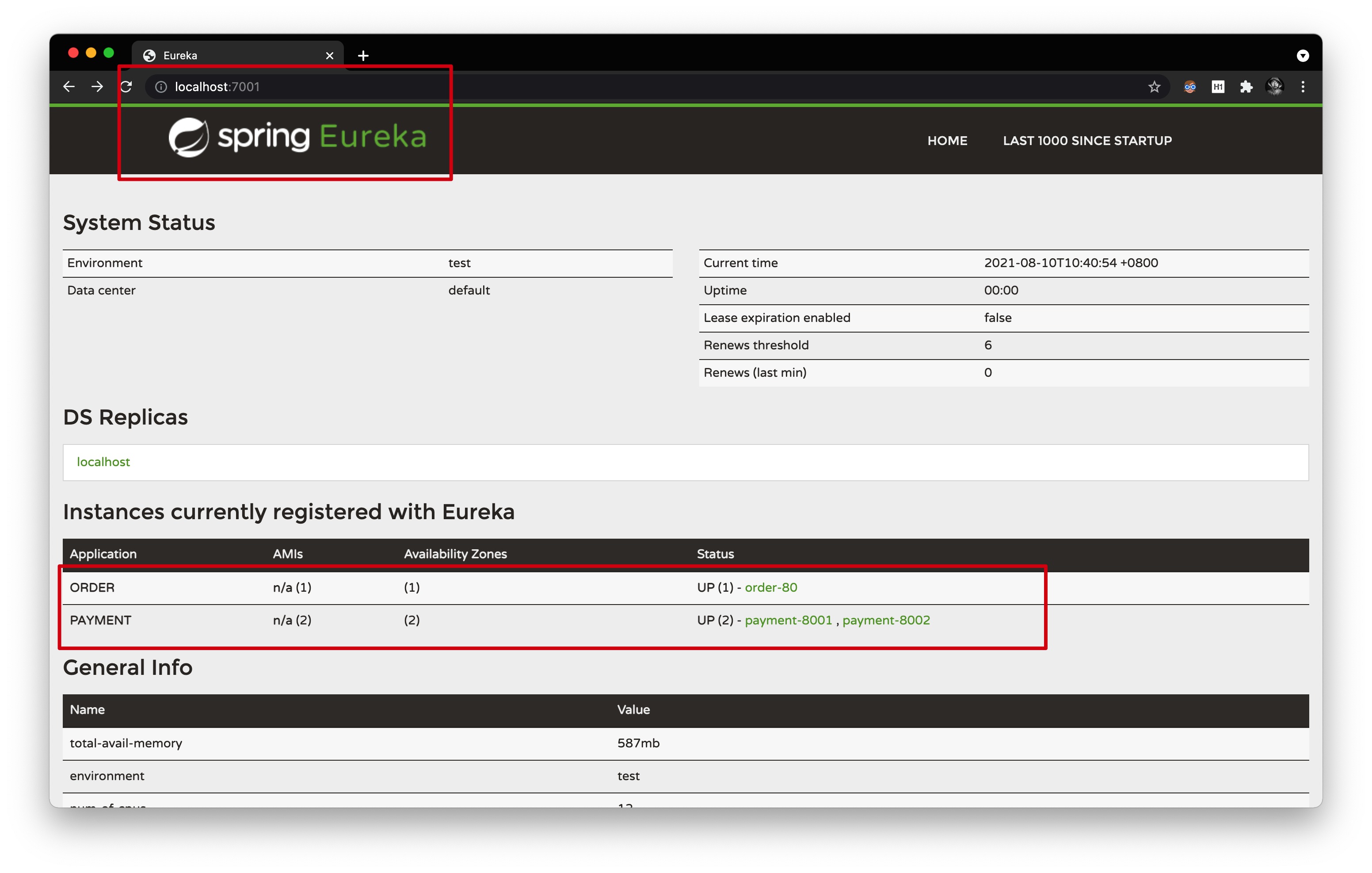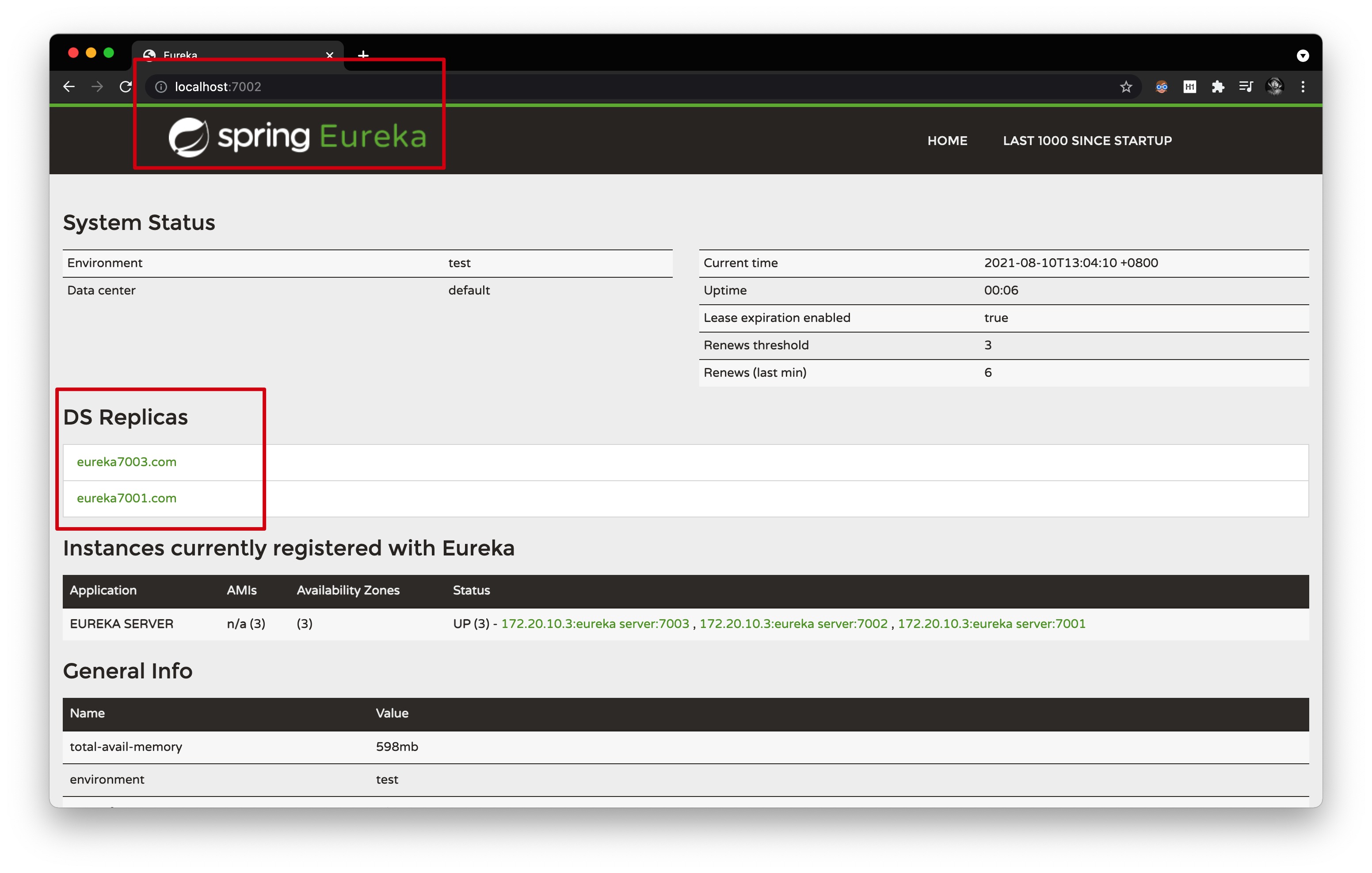Spring Cloud Eureka作为一个服务注册与发现组件,是基于Netflix Eureka的二次封装,是Spring Cloud的重要组成部分

单机版Eureka
搭建Eureka注册中心
POM依赖
在Eureka中具体包含两个组件:Eureka Server、Eureka Client。前者即为注册中心;后者则用于完成服务向注册中心的注册与发现。故这里先建立一个SpringBoot项目,用于作为Eureka Server。其POM中相关依赖如下所示
1
2
3
4
5
6
7
8
9
10
11
12
13
14
15
16
17
18
19
20
21
22
23
24
25
26
27
28
29
30
31
32
33
| <dependencyManagement>
<dependencies>
<dependency>
<groupId>org.springframework.boot</groupId>
<artifactId>spring-boot-dependencies</artifactId>
<version>2.2.2.RELEASE</version>
<type>pom</type>
<scope>import</scope>
</dependency>
<dependency>
<groupId>org.springframework.cloud</groupId>
<artifactId>spring-cloud-dependencies</artifactId>
<version>Hoxton.SR1</version>
<type>pom</type>
<scope>import</scope>
</dependency>
</dependencies>
</dependencyManagement>
<dependencies>
<dependency>
<groupId>org.springframework.cloud</groupId>
<artifactId>spring-cloud-starter-netflix-eureka-server</artifactId>
</dependency>
</dependencies>
|
配置文件
为了便于后续演示,我们在hosts文件中先添加映射,如下所示

配置文件application.yml如下所示。这里我们不需要注册中心对自身进行注册,故register-with-eureka、fetch-registry设为false
1
2
3
4
5
6
7
8
9
10
11
12
13
14
15
16
17
18
| server:
port: 7001
spring:
application:
name: eureka server
eureka:
instance:
hostname: eureka7001.com
client:
register-with-eureka: false
fetch-registry: false
service-url:
defaultZone: http://localhost:7001/eureka/
|
Java实现
作为Eureka Server而言,Java代码比较简单。我们只需提供一个SpringBoot启动类即可。值得一提的是,需要在该启动类上添加 @EnableEurekaServer 注解
1
2
3
4
5
6
7
| @SpringBootApplication
@EnableEurekaServer
public class EurekaServerApplication {
public static void main(String[] args) {
SpringApplication.run(EurekaServerApplication.class, args);
}
}
|
搭建服务提供者
POM依赖
同样再次建立一个SpringBoot项目Payment用于对外提供服务。由于该服务需要注册到Eureka中,故需要向其中引入Eureka Client依赖。如下所示
1
2
3
4
5
6
7
8
9
10
11
12
13
14
15
16
17
18
19
20
21
22
23
24
25
26
27
28
29
30
31
32
33
| <dependencyManagement>
<dependencies>
<dependency>
<groupId>org.springframework.boot</groupId>
<artifactId>spring-boot-dependencies</artifactId>
<version>2.2.2.RELEASE</version>
<type>pom</type>
<scope>import</scope>
</dependency>
<dependency>
<groupId>org.springframework.cloud</groupId>
<artifactId>spring-cloud-dependencies</artifactId>
<version>Hoxton.SR1</version>
<type>pom</type>
<scope>import</scope>
</dependency>
</dependencies>
</dependencyManagement>
<dependencies>
<dependency>
<groupId>org.springframework.cloud</groupId>
<artifactId>spring-cloud-starter-netflix-eureka-client</artifactId>
</dependency>
</dependencies>
|
配置文件
在配置文件中,我们定义了payment服务的两个实例,分别使用8001、8002端口。在启动时中通过设置不同的spring.profiles.active配置,即可启动两个使用不同端口的payment服务
1
2
3
4
5
6
7
8
9
10
11
12
13
14
15
16
17
18
19
20
21
22
23
24
25
26
27
28
29
30
31
32
33
34
35
36
37
38
39
40
41
|
spring:
application:
name: payment
profiles:
active: payment1
eureka:
client:
register-with-eureka: true
fetch-registry: true
service-url:
defaultZone: http://localhost:7001/eureka
---
spring:
profiles: payment1
server:
port: 8001
eureka:
instance:
instance-id: payment-8001
---
spring:
profiles: payment2
server:
port: 8002
eureka:
instance:
instance-id: payment-8002
|
Java实现
为便于测试,我们提供一个Controller,如下所示
1
2
3
4
5
6
7
8
9
10
11
12
13
14
15
16
17
18
19
20
21
| @RestController
@RequestMapping("pay")
public class PaymentController {
@Value("${server.port}")
private String serverPort;
@GetMapping("/getServerPort")
public String getServerPort() {
String msg = "[Payment Service]: Port: " + serverPort;
return msg;
}
@GetMapping("/hello")
public String hello(@RequestParam String name) {
String msg = "[Payment Service-"+ serverPort +"]: " + name;
return msg;
}
}
|
同时在启动类上添加 @EnableEurekaClient 注解
1
2
3
4
5
6
7
| @SpringBootApplication
@EnableEurekaClient
public class PaymentApplication {
public static void main(String[] args) {
SpringApplication.run(PaymentApplication.class, args);
}
}
|
搭建服务消费者
POM依赖
类似地,建立SpringBoot项目Order作为服务消费者。同理该项目也需要引入Eureka Client依赖。如下所示
1
2
3
4
5
6
7
8
9
10
11
12
13
14
15
16
17
18
19
20
21
22
23
24
25
26
27
28
29
30
31
32
33
| <dependencyManagement>
<dependencies>
<dependency>
<groupId>org.springframework.boot</groupId>
<artifactId>spring-boot-dependencies</artifactId>
<version>2.2.2.RELEASE</version>
<type>pom</type>
<scope>import</scope>
</dependency>
<dependency>
<groupId>org.springframework.cloud</groupId>
<artifactId>spring-cloud-dependencies</artifactId>
<version>Hoxton.SR1</version>
<type>pom</type>
<scope>import</scope>
</dependency>
</dependencies>
</dependencyManagement>
<dependencies>
<dependency>
<groupId>org.springframework.cloud</groupId>
<artifactId>spring-cloud-starter-netflix-eureka-client</artifactId>
</dependency>
</dependencies>
|
配置文件
一般地,微服务中一个服务既是提供者也是消费者,故我们也将该服务注册到Eureka中。配置如下
1
2
3
4
5
6
7
8
9
10
11
12
13
14
15
16
17
18
| server:
port: 80
spring:
application:
name: order
eureka:
client:
register-with-eureka: true
fetch-registry: true
service-url:
defaultZone: http://localhost:7001/eureka
instance:
instance-id: order-80
|
Java实现
首先声明创建RestTemplate实例。一个是普通的RestTemplate实例,一个则是添加了 @LoadBalanced 注解的RestTemplate实例。前者可进行基于IP、Port服务调用;后者由于添加了 @LoadBalanced 注解,其一方面可进行基于服务名的服务调用,另一方面支持负载均衡
1
2
3
4
5
6
7
8
9
10
11
12
13
14
15
16
17
18
19
20
21
22
23
24
25
| @Configuration
public class RestTemplateConfig {
@Bean
public RestTemplate restTemplate1() {
return new RestTemplate();
}
@Bean
@LoadBalanced
public RestTemplate restTemplate2() {
return new RestTemplate();
}
}
|
然后通过Controller调用Payment服务接口。下面展现了 传统地基于IP、Port信息 和 基于服务名 两种形式的服务调用
1
2
3
4
5
6
7
8
9
10
11
12
13
14
15
16
17
18
19
20
21
22
23
24
25
26
27
28
29
30
31
32
| @RestController
@RequestMapping("order")
public class OrderController {
@Qualifier("restTemplate1")
@Autowired
private RestTemplate restTemplate1;
@Qualifier("restTemplate2")
@Autowired
private RestTemplate restTemplate2;
private static final String PAYMENT_URL_1 = "http://localhost:8001";
private static final String PAYMENT_URL_2 = "http://PAYMENT";
@GetMapping("/test1")
public String test1(@RequestParam String name) {
String msg = restTemplate1.getForObject(PAYMENT_URL_1 +"/pay/hello?name={1}", String.class, name);
String result = "[Order Service #test1]: " + msg;
return result;
}
@GetMapping("/test2")
public String test2(@RequestParam String name) {
String msg = restTemplate2.getForObject(PAYMENT_URL_2 +"/pay/hello?name={1}", String.class, name);
String result = "[Order Service #test2]: " + msg;
return result;
}
}
|
最后,在启动类上添加 @EnableEurekaClient 注解
1
2
3
4
5
6
7
| @SpringBootApplication
@EnableEurekaClient
public class OrderApplication {
public static void main(String[] args) {
SpringApplication.run(OrderApplication.class, args);
}
}
|
测试
启动Eureka Server、Payment、Order三个服务。其中,Payment服务启动了两个实例,如下所示

打开 http://localhost:7001 ,进入Eureka Server的Web页面,可以看到Payment、Order服务都已经被成功注册到Eureka当中。其中Payment服务下存在两个实例

现在我们通过Order服务来调用Payment服务的接口,测试结果如下,符合预期。与此同时,红框结果同时表明实现了负载均衡

集群版Eureka环境
Eureka集群环境搭建也比较简单,只是相关的配置文件发生变化。这里就Server、Client侧分别说明
Eureka Server配置
在Eureka集群环境中,各实例的 eureka.client.service-url.defaultZone 不再是指向自己,而是指向集群下的其它实例。下面即是一个包含三实例的Eureka集群配置,如下所示
1
2
3
4
5
6
7
8
9
10
11
12
13
14
15
16
17
18
19
20
21
22
23
24
25
26
27
28
29
30
31
32
33
34
35
36
37
38
39
40
41
42
43
44
45
46
47
48
49
50
51
52
53
54
55
56
57
58
59
60
61
62
63
64
65
66
|
spring:
application:
name: eureka server
profiles:
active: eurekaServer1
---
spring:
profiles: eurekaServer1
server:
port: 7001
eureka:
instance:
hostname: eureka7001.com
client:
register-with-eureka: true
fetch-registry: true
service-url:
defaultZone: http://eureka7002.com:7002/eureka/, http://eureka7003.com:7003/eureka/
---
spring:
profiles: eurekaServer2
server:
port: 7002
eureka:
instance:
hostname: eureka7002.com
client:
register-with-eureka: true
fetch-registry: true
service-url:
defaultZone: http://eureka7001.com:7001/eureka/, http://eureka7003.com:7003/eureka/
---
spring:
profiles: eurekaServer3
server:
port: 7003
eureka:
instance:
hostname: eureka7003.com
client:
register-with-eureka: true
fetch-registry: true
service-url:
defaultZone: http://eureka7001.com:7001/eureka/, http://eureka7002.com:7002/eureka/
|
启动该集群环境后,进入任一一个Eureka实例的Web页面,即可看到整个集群环境已经建立完毕。如下所示

Eureka Client配置
Eureka Client的配置就比较简单,我们以payment服务为例。只需将 eureka.client.service-url.defaultZone 配置项指向Eureka集群的各实例即可,如下所示
1
2
3
4
5
6
7
8
9
10
11
12
13
14
15
16
17
|
spring:
application:
name: payment
profiles:
active: payment1
eureka:
client:
register-with-eureka: true
fetch-registry: true
service-url:
defaultZone: http://eureka7001.com:7001/eureka,http://eureka7002.com:7002/eureka,http://eureka7003.com:7003/eureka
|
Note
- IDEA下启动某个服务的多实例,需要先勾选 Allow parallel 配置

参考文献
- Spring微服务实战 John Carnell著







